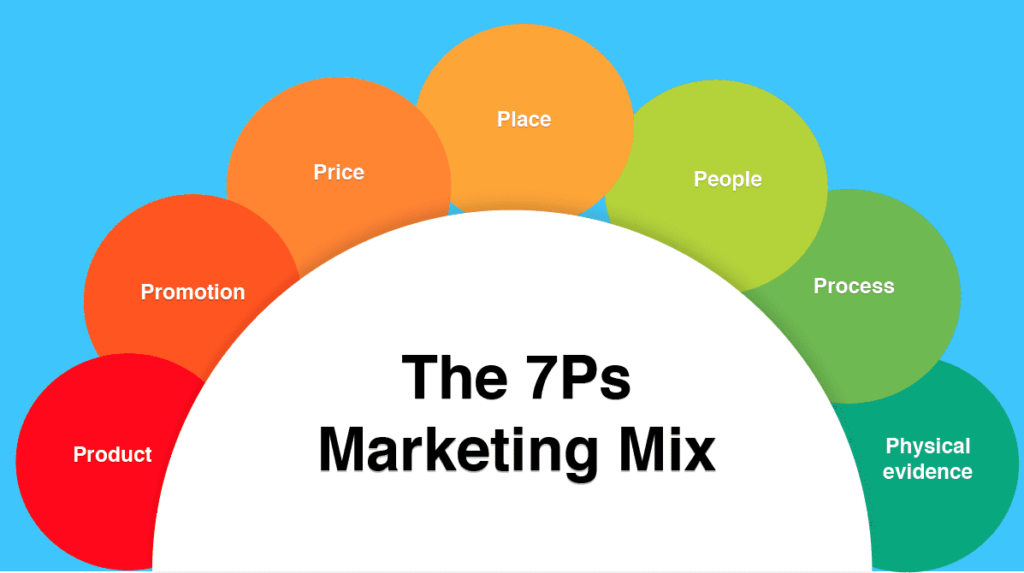What are the 7 Ps of Marketing?

![]()
The 7 Ps of Marketing is a framework that helps businesses refine their marketing strategies by focusing on key elements. Originally based on the 4 Ps (Product, Price, Place, Promotion), it was later expanded to include three additional elements (People, Process, and Physical Evidence). Here’s a detailed explanation of each:
1. Product
Definition: The actual goods or services a company offers to meet the needs or wants of customers.
Details:
- It could be a tangible item (like a car or a mobile phone) or an intangible service (like insurance or consulting).
- The key aspects to consider include quality, design, features, packaging, branding, and after-sales service.
- A well-defined product should solve a problem or fulfill a need and provide real value to the customer.
- Businesses must continuously innovate to stay competitive, adjusting their product offerings based on market feedback.
2. Price
Definition: The amount of money customers are willing to pay for a product or service.
Details:
- Pricing strategies can vary, including penetration pricing, skimming, premium pricing, or economy pricing.
- Price affects the customer’s perception of value. Too high, and customers might not buy; too low, and they may doubt the quality.
- Pricing must account for production costs, target market, competition, and profit margins.
- Discounts, promotions, and financing options are also part of the pricing strategy.
3. Place
Definition: The locations or channels where the product is distributed and made available to customers.
Details:
- This encompasses the logistics of getting the product to the customer, whether it’s physical retail stores, online platforms, or a direct-to-consumer approach.
- Businesses must consider factors like distribution channels, market coverage, inventory management, and logistics.
- The goal is to make the product easily accessible to the target audience through the most effective channels.
4. Promotion
Definition: The activities and strategies used to make the product or service known to customers.
Details:
- Promotion includes advertising, public relations, sales promotions, and personal selling.
- Digital marketing, such as social media campaigns, content marketing, email marketing, and influencer marketing, has become increasingly significant.
- Effective promotion communicates the product’s value and persuades potential customers to take action.
- The key is choosing the right mix of promotional activities to reach the target audience and maximize impact.
5. People
Definition: The individuals involved in delivering the product or service to customers.
Details:
- This includes both the employees who deliver the product/service and the customers who interact with the company.
- Customer service, sales teams, and support staff must be well-trained to provide excellent service, as their interactions shape the customer’s experience.
- Businesses should focus on recruiting, training, and retaining the right people to represent the brand effectively.
- Satisfied employees often lead to satisfied customers, creating a positive cycle of growth and brand loyalty.
6. Process
Definition: The systems and processes that deliver a product or service to customers.
Details:
- This includes everything from product manufacturing to the customer journey, from awareness to post-purchase service.
- Efficient processes ensure that the customer experience is consistent and smooth.
- Businesses must streamline operations, from order fulfillment to customer feedback loops, to enhance customer satisfaction.
- The more seamless the process, the better the perceived value by customers, leading to increased loyalty and repeat business.
7. Physical Evidence
Definition: The tangible elements that help customers judge the quality of the product or service.
Details:
- This can be anything from the physical environment where the service is delivered (such as a clean and welcoming store or website) to the packaging of the product itself.
- Branding, website design, company brochures, and even the appearance of employees contribute to physical evidence.
- In service industries, where the product is intangible, physical evidence helps customers feel more confident in their purchase.
- Positive physical evidence enhances the customer’s perception of value and builds trust in the brand.
By addressing each of these 7 Ps, businesses can create a comprehensive marketing strategy that not only attracts customers but also builds long-term loyalty. Each element interacts with the others, making it essential to balance them based on the company’s goals and customer expectations.
